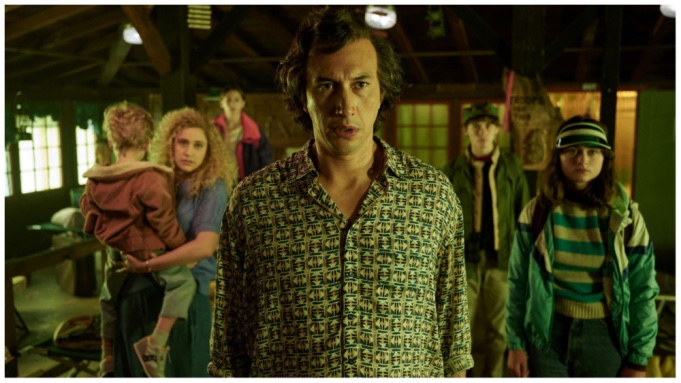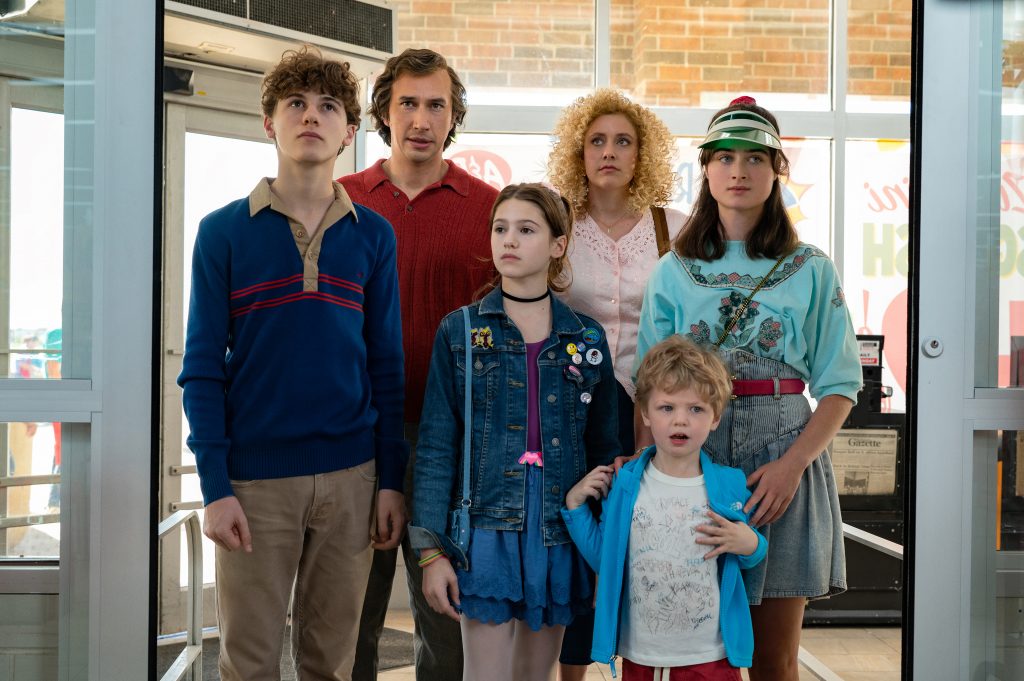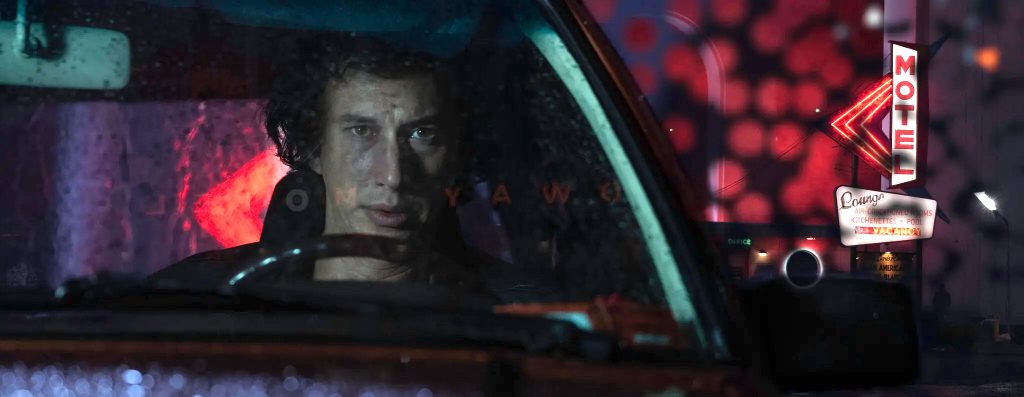
Courtesy of Netflix
SOURCE: Cleveland Magazine | Dillon Stewart
November 23, 2022
The new movie starring Adam Driver filmed for more than six months, tapped into local crews and used Wellington, Akron and downtown Cleveland to create the universe of Don DeLillo’s iconic novel. By Dillon Stewart
Late last July, actors Greta Gerwig and Adam Driver mill around outside Addie’s Antiques in Wellington, 45 minutes southwest of Cleveland. Chatting off camera, Gerwig sports a frizzy mop of hairsprayed curls, and Driver hides a paunch under a plaid dress shirt. Most businesses neighboring Addie’s, an actual functioning antique shop, have been transformed into brightly colored restaurants, nightclubs and other fictional storefronts. Sitting in lawn chairs next to paparazzi, locals gawk at the spectacle as if watching an Independence Day parade, and some even get in on the action as extras on this Hollywood film set.
The meta ‘80s fever dream is the brainchild of director Noah Baumbach for his upcoming film, White Noise. But Hollywood descending upon Northeast Ohio is becoming a common scene. Fast and the Furious and Captain America: Winter Soldier shot scenes in and around Downtown Cleveland, and White Boy Rick and Cherry, directed by Cleveland natives John and Joe Russo, filmed almost entirely in the area. Heck, this is even the second film to hit Wellington, a town of just more than 4,000, which hosted Liam Neeson’s film The Minuteman in 2019.

Courtesy of Netflix
But White Noise is different. Author Don DeLillo’s timely, anxiety-riddled ‘80s novel was deemed by some in the industry as “unadaptable” after a few false starts in the early 2000s. The book’s overwhelming feeling of existential dread, strong internal dialogue and unseen threat probably abetted that narrative. But doing it right, according to Baumbach, was enough to give most money men a different kind of dread.
Local crew members describe a spare-no-expense approach that included shutting down a stretch of highway for six weeks, transforming an abandoned Walmart into a film stage, building a faux motel under the Inner Belt Bridge in the Flats, digging a river in rural Ohio and spinning dozens of rolls of real, tactile film.
And that’s exactly what Netflix did. Bill Garvey, president of the Greater Cleveland Film Commission, estimates White Noisespent more than $100 million in Northeast Ohio — the most of any movie to date. Netflix’s original budget was about $82 million, but an extended shoot and an artist-first philosophy drove that up to a rumored $140 million, though official audits won’t come out until next year.
“We have such a diversity of looks here,” says Garvey. “That and the logistical ease of working here is what gets them here. But it is limited by the $40 million [tax incentive] cap we have.”
Production designer Jess Gonchor, who won an Academy Award for True Grit in 2010, is a master of building universes. This project called for a true-to-life Midwestern setting, one with spacious supermarkets, a boy scout camp, a college campus and housing stock that looked like Anywhere, USA. Only one place came to mind: Northeast Ohio.
“I don’t think we could have done this anywhere else in the country,” says Gonchor. “We took major advantages of the locations and kindness of the people. There are not a lot of places that are interested in letting you do that kind of stuff.”
Tasked with setting the scene for DeLillo’s novel, which follows a professor and his family as they react to an airborne toxic event in a “Middle America” college town, Gonchor first explored upstate New York, near Buffalo. Around the time that fell through, Gonchor found an interview where DeLillo mentioned being inspired by a supermarket in Chagrin Falls.
Gonchor never found that supermarket, but two hours west of Buffalo, he did find the perfect location to recreate the book’s fictional town of Blacksmith. In the classrooms of the University of Akron, he saw Jack Gladney’s lecture hall. Wellington and Oberlin perfectly played the cozy town surrounding “College-on-the-Hill.” Peninsula’s Camp Manitoc had a dusty sheen of reality perfect for the boy scout camp to which the Gladney family would eventually escape.
Still, Gonchor admits the deciding factor typically comes down to budget and logistical ease.
“I always try to do, first and foremost, what’s right for the movie,” he says. “But, fortunately and unfortunately, a lot of movies these days are driven by tax incentives.”
The Ohio Motion Picture Tax Credit incentives were created in 2009 to encourage studios to make movies, shows, video games, theatrical productions and more in the state. For those spending more than $300,000, Ohio offers a refundable tax credit of 30% on production cast and crew wages and other in-state spending.
But Ohio caps these incentives at a combined $40 million per year. That means if (the fictional) LeBron James on Ice eats up $20 million in tax credits, the studio behind The Wild Adventures of Cleveland Magazine Editor Dillon Stewart (in the very early stages of pre-production) only has the remaining $20 million with which to play.

Courtesy of Netflix
Meanwhile, states such as New Mexico and Louisiana have used a $100 million cap to become leaders in the film industry, and Georgia pulled in $4.4 billion in fiscal year 2022 by not having any cap at all.
Opponents call these credits a bad deal for taxpayers. They say these filmmakers would work here anyway. But Garvey points to ripples like the 36,000 nights spent in local hotels by White Noise crewmembers. The NFL Draft, meanwhile, saw an 85% hotel occupancy rate among 26 hotels for one weekend — a number closer to 10,000 nights. A study by consulting firm Olsberg SPI found, from 2010-2020, a $3.09 return for every dollar in tax credits and that 134 projects created 6,192 full-time equivalent jobs and $1.1 billion in total gross economic output. Meanwhile, more than $200 million was turned away due to the tax incentive cap, Garvey says.
“The opportunities have grown exponentially over the past few years, but it’s not at its peak,” says Evan Prunty, co-founder of Black Valve Media who served as a video playback operator on White Noise. Throughout DeLillo’s novel, television clips puncture real life with snippets of consumer culture, creating a uniquely modern state of anxiety. Prunty worked to recreate that motif with the television sets and other circa-1980s props you see throughout the film.
As a member of the Local 209 union, which represents entertainment industry members in Ohio and Northern Kentucky, Prunty is on a list of local crewmembers that studios can tap when making films. He pays $1,500 in dues, which he says “pays off tenfold.”
Studios actually prefer to use local talent, Gonchor says. It’s cheaper. But it’s not always possible.
“When Cherry and Judas and the Black Messiah filmed in Cleveland at the same time, there was nobody left to hire in the area,” Prunty says. “It’s not like there are people sitting around. If there’s a movie, there’s work for you. I guarantee it.”